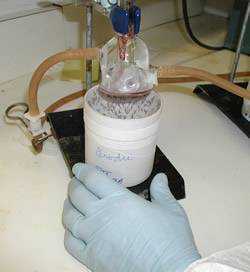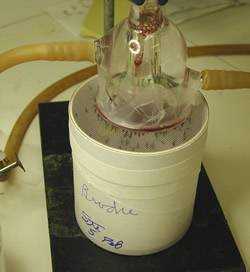CDC’s Research Resources
CDC’s Insectary
CDC’s insectary maintains colonies of Anopheles mosquitoes collected from areas of the world where malaria is or can be transmitted. The mosquitoes are raised in a climate-controlled insectary with additional rooms for secure biological containment of malaria-infected vectors. These vector species are used for both transmission experiments and vector genetics and behavioral studies.
The facilities also serve as a repository for the active collection and study of over a dozen species and numerous isolates of malaria parasites of human and nonhuman primates. The investigations are carried out in vivo in animals or mosquito vectors and in vitro where possible through tissue culture of the parasite.
Mosquito Colonies
The vector colonies are from the United States (Anopheles quadrimaculatus and An. freeborni); India (An. stephensi); Africa (An. gambiae and An. arabiensis); Southeast Asia/Thailand (An. dirus, An. sawadwongporni, and An. minimus); Papua New Guinea (An. farauti); Spain (An. atroparvus); and El Salvador (An. albimanus).


Mosquitoes being fed experimentally using a parafilm membrane; the blood meal is pumped on top of the membrane.
CDC’s Animal Facility
CDC maintains a large modern animal facility in Chamblee, Georgia, approved by the American Association for the Accreditation of Laboratory Animal Care, International. This resource provides a platform for transmission, infection, and disease models to help provide the knowledge that will facilitate the improvement and development of new malaria interventions through vaccines, chemotherapy, or transmission reduction and elimination.
Primate Malaria Species and Their Use
Sixteen species of primate malaria parasites are maintained in laboratory cultures or experimental animals, or stored frozen in liquid nitrogen. These include isolates of all four species of human malaria parasites (Plasmodium falciparum, P. vivax, P. ovale, and P. malariae) collected from different areas of the world at different times. They also include monkey malaria parasites (P. cynomolgi, P. knowlesi, P. inui, P. gonderi, P. fieldi, P. simiovale, P. coatneyi, P. fragile, P. simium, and P. brasilianum) that have strong similarities to human malaria parasites. The recent finding that P. knowlesi, a species of malaria that naturally infects macaques in Southeast Asia, also infects humans ("zoonotic" malaria) highlights the value of maintaining these parasites for studies.
Studying these parasites during passage through mosquitoes, monkeys, and culture allows the modeling of parasite-host relationships on immunity, pathology, and the effectiveness of antimalarial drugs. New isolates and strains of malaria parasites are collected, adapted to laboratory culture or nonhuman primates, and tested using the latest available treatments.
Primates and Their Contribution
The CDC Chamblee animal facility houses several New World primate species, such as Aotus nancymai, A. vociferans (owl monkeys), and Saimiri boliviensis (squirrel monkeys); and Old World monkeys, such as Macaca mulatta and M. fascicularis (both macaques) from regulated feral colonies, commercial breeders, or in-house laboratory-born under the direction of the resident clinical veterinarian. All protocols are reviewed and approved by the institutional Animal Care and Use Committee in accordance with procedures described in the U. S. Public Health Service Policy, 1986.
The New World primates are used for experimental infections with either human malaria species (except P. ovale) or simian (monkey) malaria species (normally parasites of the Old World monkeys). New World primates are the only available animal models to study vaccine efficacy or drug susceptibility of human malaria parasites. The macaques, Old World primates, when infected with simian malaria parasites make excellent models for the biology of the human malarias. These nonhuman primate hosts of human and simian malaria parasites also offer faithful models to investigate mechanisms and treatments for severe pathology associated with malaria infections such as anemia, cerebral malaria, and malaria in pregnancy.
Malaria Research and Reference Reagent Resource Center (MR4)
CDC plays a vital role in the Malaria Research and Reference Reagent Resource Center (MR4), to provide vector-related materials to qualified MR4 users. These materials include approximately 40 strains and species of Anopheles mosquitoes, along with preserved material, genomic DNAs, information, and primers for vector species identification. CDC has also donated numerous Plasmodium parasites to MR4. Together, these constitute an unmatched biological resource, facilitating continued research on standardized strains and providing reference material to private, government, and academic researchers.
DPDx
CDC maintains DPDx, a web site to strengthen the diagnosis of parasitic diseases, including malaria, both in the United States and abroad.
The site contains concise reviews of parasites and parasitic diseases, including an image library and a review of recommended procedures for collecting, shipping, processing, and examining biologic specimens and provides diagnostic assistance. Laboratorians and other health professionals can ask questions and/or send digital images of specimens for expedited review and consultation with CDC staff free of charge.
- Page last reviewed: February 8, 2010
- Page last updated: February 8, 2010
- Content source:


 ShareCompartir
ShareCompartir